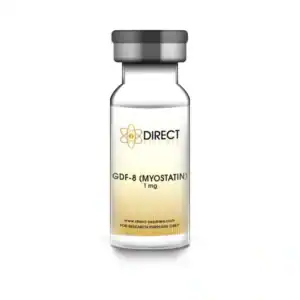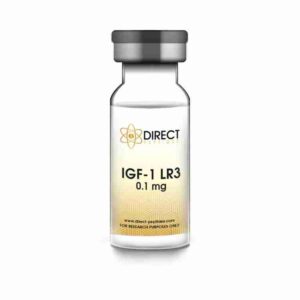Muscle-wasting diseases, like muscular dystrophy and cachexia, cause severe muscle loss. This leads to weakness and makes even simple daily tasks difficult. Current treatments mostly focus on easing symptoms, but they don’t address the root cause of muscle degeneration. Researchers are now exploring myostatin peptides for muscle regeneration as a potential solution.
These peptides may help reverse muscle loss and promote muscle growth, offering hope for those suffering from muscle-wasting diseases. But before we look at how myostatin peptides can help, let’s first understand the role of myostatin in muscle growth.
The peptides discussed in this article are intended for research purposes only and are not approved for human use.
Myostatin is a protein naturally found in the body. It limits muscle growth by acting like a “brake” on muscle development. For most individuals, this is useful because it keeps muscles from growing uncontrollably. However, in individuals with muscle-wasting diseases, myostatin works against them. It prevents the body from repairing and regenerating muscle tissue, worsening muscle loss.
In diseases like muscular dystrophy and cachexia, the body loses muscle faster than it can regenerate it. Since myostatin blocks muscle growth, it makes the problem worse. Myostatin inhibitors or myostatin peptides for muscle regeneration can stop myostatin from working, allowing the body to repair and regrow muscle tissue. With this understanding in place, let’s look at how blocking myostatin might promote muscle regeneration.
Explore Myostatin Peptides from Direct Peptides Europe, designed to block myostatin and promote muscle regeneration for muscle-wasting diseases.
Myostatin peptides work by blocking the action of myostatin. These peptides prevent myostatin from stopping muscle growth. When myostatin is blocked, the body can regenerate muscle tissue more easily. This means that myostatin peptides could help individuals with muscle-wasting diseases regenerate lost muscle mass.
Animal studies have shown that myostatin inhibitors for muscle-wasting diseases can increase muscle size and strength by allowing the body to regenerate muscle tissue. This is exciting because it suggests myostatin peptides could provide a new way to treat muscle loss, especially in diseases like muscular dystrophy and cachexia.
Explore Peptide Supplies at Direct Peptides Europe for all your reconstitution requirements.
 In animal studies, researchers used myostatin peptides to block myostatin. These studies showed that myostatin inhibitors helped animals grow more muscle.
In animal studies, researchers used myostatin peptides to block myostatin. These studies showed that myostatin inhibitors helped animals grow more muscle.
The animals became stronger and healthier, which shows that myostatin peptides might help reverse some of the damage caused by muscle-wasting diseases.
While this research is promising, it’s still early. We need more studies to understand how these peptides will work in humans. Clinical trials will be needed to confirm their safety and effectiveness for treating muscle loss with myostatin peptides in humans.
As we continue to explore this possibility, let’s consider whether myostatin peptides could be a breakthrough for specific diseases, such as muscular dystrophy.
One of the most exciting possibilities for myostatin peptides is in treating muscular dystrophy. This disease causes muscle weakness and wasting, and it gets worse over time.
Individuals with muscular dystrophy lose muscle mass because their body can’t repair muscles properly. Myostatin peptides for muscular dystrophy treatment could help by blocking myostatin’s action and allowing the body to regenerate muscle tissue.
If myostatin peptides can help promote muscle growth, they could provide a new treatment for muscular dystrophy that slows or stops muscle loss. Although muscular dystrophy treatment with myostatin peptides is still in early stages, the potential to improve quality of life for patients is significant. But can these peptides help in other diseases that cause muscle loss? Let’s see how they can help treat cachexia.
 Cachexia is another condition that causes muscle loss, often seen in patients with cancer or chronic diseases. It leads to extreme weight loss and weakness, making it hard for individuals to recover.
Cachexia is another condition that causes muscle loss, often seen in patients with cancer or chronic diseases. It leads to extreme weight loss and weakness, making it hard for individuals to recover.
Just like in muscular dystrophy, the body loses muscle tissue faster than it can repair it. Myostatin peptides could help treat cachexia by blocking myostatin and allowing the muscles to regenerate.
By using myostatin inhibitors, we may be able to slow down or stop muscle loss in individuals with cachexia. This could be a huge step forward in improving recovery and overall health for people suffering from this condition.
If successful, it would not only improve the quality of life for these patients but also provide a tool for managing the symptoms of cachexia in a way that current treatments cannot.
In addition to myostatin peptides, there are several other peptides that also show potential in promoting muscle recovery. These peptides can work together with myostatin inhibitors to further support muscle regeneration and treat muscle-wasting diseases more effectively.
While myostatin peptides for muscle regeneration have shown a lot of potential for promoting muscle growth, other peptides also play an important role in muscle recovery. These peptides can work together with myostatin inhibitors for muscle-wasting diseases to treat muscle loss in a more complete way. Let’s explore some of these additional peptides and how they contribute to muscle regeneration.
 ACE-031 is a peptide that blocks myostatin, a protein that prevents muscles from growing. By preventing myostatin from binding to its receptor on muscle cells, ACE-031 allows muscles to grow and repair.
ACE-031 is a peptide that blocks myostatin, a protein that prevents muscles from growing. By preventing myostatin from binding to its receptor on muscle cells, ACE-031 allows muscles to grow and repair.
This is especially helpful for individuals with muscular dystrophy and other muscle-wasting diseases, as it slows down muscle loss and promotes muscle regeneration.
ACE-031 has shown good results in animal studies, where it increased muscle mass and strength. This could be a key treatment for muscle problems caused by diseases. As we look at ACE-031’s role in muscle regeneration, let’s also consider how other peptides like IGF-1 LR3 complement this approach.
Discover ACE-031 at Direct Peptides Europe, a potent myostatin inhibitor that helps increase muscle mass and strength in muscle-wasting conditions.
 IGF-1 LR3 is another peptide that helps muscles grow by increasing protein production and encouraging muscle cell growth.
IGF-1 LR3 is another peptide that helps muscles grow by increasing protein production and encouraging muscle cell growth.
Unlike myostatin peptides, which block myostatin’s action, IGF-1 LR3 directly promotes muscle regeneration.
When used with myostatin peptides, IGF-1 LR3 can speed up muscle recovery.
This makes IGF-1 LR3 especially helpful for individuals with conditions like cachexia or muscular dystrophy, where muscle regeneration is crucial. By pairing it with myostatin inhibitors, we create a powerful combination for muscle growth.
Explore IGF-1 LR3 from Direct Peptides Europe, a powerful peptide that stimulates muscle growth and enhances recovery for conditions like cachexia.
 Follistatin 344 works similarly to myostatin peptides by blocking myostatin.
Follistatin 344 works similarly to myostatin peptides by blocking myostatin.
However, it goes a step further by binding to other proteins that are important for muscle growth, making it an even more potent tool for muscle regeneration.
Follistatin 344 can prevent myostatin from limiting muscle growth, helping muscles grow faster and more efficiently. In animal studies, Follistatin 344 has increased muscle mass and strength.
For individuals with muscle-wasting diseases, this peptide could be a great addition to myostatin peptide treatments, helping to rebuild muscle more quickly.
Check out Follistatin 344 at Direct Peptides Europe, a peptide that blocks myostatin and promotes faster muscle growth and regeneration for muscle loss treatment.
 Finally, MK-677 (also called Ibutamoren) works by increasing the release of growth hormone (GH), which is essential for muscle growth. GH increases protein production and supports muscle cells in growing and repairing.
Finally, MK-677 (also called Ibutamoren) works by increasing the release of growth hormone (GH), which is essential for muscle growth. GH increases protein production and supports muscle cells in growing and repairing.
While MK-677 doesn’t directly stop myostatin, it can work well with myostatin peptides to speed up muscle recovery. By raising GH levels, MK-677 creates a good environment for muscle regrowth.
This peptide is especially useful for individuals with muscle-wasting diseases like cachexia, where low growth hormone levels can hinder recovery.
Discover MK-677 from Direct Peptides Europe, a growth hormone secretagogue that boosts muscle recovery and promotes lean muscle mass for better health.
Myostatin peptides offer a promising new approach to treating muscle-wasting diseases. By inhibiting myostatin, these peptides could help regenerate muscle tissue, offering hope for conditions like muscular dystrophy and cachexia.
While the research is still in its early stages, the results from animal studies are promising. The future of muscle regeneration peptides looks bright, and if myostatin peptides are proven safe and effective, they could revolutionize the way we treat these debilitating diseases.
Additionally, ACE-031, IGF-1 LR3, Follistatin 344, and MK-677 are all peptides that could be used alongside myostatin inhibitors for muscle-wasting diseases to create a more effective treatment strategy. These peptides work in different ways to enhance muscle growth and regeneration, making them valuable in the fight against muscle-wasting diseases.
As research progresses, we may soon see these peptides become key parts of treatments that help those suffering from muscle-wasting diseases regain their strength and independence.
1 McPherron AC, Lawler AM, Lee SJ. Regulation of skeletal muscle mass in mice by a new TGF-beta superfamily member. Nature. 1997 May 1;387(6628):83-90.
2 Lee SJ. Regulation of muscle mass by myostatin. Annu Rev Cell Dev Biol. 2004;20:61-86.
3 Zhang C, McFarlane C, Lokireddy S, Bonala S, Ge X, Masuda S, Gluckman PD, Sharma M, Kambadur R. Myostatin-deficient mice exhibit reduced insulin resistance through activating the AMP-activated protein kinase signalling pathway. Diabetologia. 2011 Jun;54(6):1491-501.
4 Amthor H, Macharia R, Navarrete R, Schuelke M, Brown SC, Otto A, Voit T, Muntoni F, Vrbóva G, Partridge T, Zammit P, Bunger L, Patel K. Lack of myostatin results in excessive muscle growth but impaired force generation. Proc Natl Acad Sci U S A. 2007 Feb 6;104(6):1835-40.
5 Wolfman NM, McPherron AC, Pappano WN, Davies MV, Song K, Tomkinson KN, Wright JF, Zhao L, Sebald SM, Greenspan DS, Lee SJ. Activation of latent myostatin by the BMP-1/tolloid family of metalloproteinases. Proc Natl Acad Sci U S A. 2003 Dec 23;100(26):15842-6.
Shop ALL Peptide Vials from Direct Peptides Europe today, your trusted supplier of premium clinical grade peptides online.

MK-677 Capsules
£41.87 Select options This product has multiple variants. The options may be chosen on the product page
GDF-8 Myostatin Peptide Vial
£88.19 – £97.17Price range: £88.19 through £97.17 Select options This product has multiple variants. The options may be chosen on the product page
Follistatin 344 Nasal Spray
£96.69 – £188.38Price range: £96.69 through £188.38 Select options This product has multiple variants. The options may be chosen on the product page
ACE-031 1mg Pre Mixed
£99.00 – £267.30Price range: £99.00 through £267.30 Select options This product has multiple variants. The options may be chosen on the product pageALL CONTENT AND PRODUCT INFORMATION AVAILABLE ON THIS WEBSITE IS FOR EDUCATIONAL PURPOSES ONLY.
DISCLAIMER: These products are intended solely as a research chemical only. This classification allows for their use only for research development and laboratory studies. The information available on our Europe Direct Peptides website: https://direct-peptides.com is provided for educational purposes only. These products are not for human or animal use or consumption in any manner. Handling of these products should be limited to suitably qualified professionals. They are not to be classified as a drug, food, cosmetic, or medicinal product and must not be mislabelled or used as such.